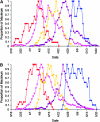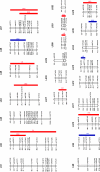The genetic architecture of reproductive isolation in Louisiana irises: flowering phenology
- PMID: 17237511
- PMCID: PMC1855133
- DOI: 10.1534/genetics.106.068338
The genetic architecture of reproductive isolation in Louisiana irises: flowering phenology
Abstract
Despite the potential importance of divergent reproductive phenologies as a barrier to gene flow, we know less about the genetics of this factor than we do about any other isolating barrier. Here, we report on the genetic architecture of divergent flowering phenologies that result in substantial reproductive isolation between the naturally hybridizing plant species Iris fulva and I. brevicaulis. I. fulva initiates and terminates flowering significantly earlier than I. brevicaulis. We examined line crosses of reciprocal F1 and backcross (BC1) hybrids and determined that flowering time was polygenic in nature. We further defined quantitative trait loci (QTL) that affect the initiation of flowering in each of these species. QTL analyses were performed separately for two different growing seasons in the greenhouse, as well as in two field plots where experimental plants were placed into nature. For BCIF hybrids (BC1 toward I. fulva), 14 of 17 detected QTL caused flowering to occur later in the season when I. brevicaulis alleles were present, while the remaining 3 caused flowering to occur earlier. In BCIB hybrids (BC1 toward I. brevicaulis), 11 of 15 detected QTL caused flowering to occur earlier in the season when introgressed I. fulva alleles were present, while the remaining 4 caused flowering to occur later. These ratios are consistent with expectations of selection (as opposed to drift) promoting flowering divergence in the evolutionary history of these species. Furthermore, epistatic interactions among the QTL also reflected the same trends, with the majority of epistatic effects causing later flowering than expected in BCIF hybrids and earlier flowering in BCIB hybrids. Overlapping QTL that influenced flowering time across all four habitat/treatment types were not detected, indicating that increasing the sample size of genotyped plants would likely increase the number of significant QTL found in this study.
Figures




References
-
- Arnold, M. L., 1993. Iris nelsonii: origin and genetic composition of a homoploid hybrid species. Am. J. Bot. 80: 577–583. - PubMed
-
- Arnold, M. L., 1997. Natural Hybridization and Evolution. Oxford University Press, New York.
-
- Arnold, M. L., 2006. Evolution Through Genetic Exchange. Oxford University Press, New York.
-
- Bouck, A. C., 2004. The Genetic Architecture of Reproductive Isolation in Louisiana Irises. Ph.D. Dissertation, University of Georgia, Athens, GA.
Publication types
MeSH terms
LinkOut - more resources
Full Text Sources

